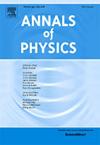广义Landau-Zener振动模型的隐sl(2)-对称性
IF 3
3区 物理与天体物理
Q2 PHYSICS, MULTIDISCIPLINARY
引用次数: 0
摘要
一维谐波振动模型是所谓的线性朗多-齐纳模型的推广,以耦合Schrödinger方程的形式出现。解耦后,得到的四阶方程具有隐藏的sl(2)代数。然后用一种相当简单的方式来表示所谓的异常部分。为了完备性,本征函数直接在位置空间中通过贝特ansatz方法得到。本文章由计算机程序翻译,如有差异,请以英文原文为准。
Hidden sl(2)-symmetry of the generalized Landau–Zener vibronic model
The one-dimensional harmonic vibronic model, which is a generalization of the so-called linear Landau–Zener model and appears in the form of coupled Schrödinger equations, is revisited. After decoupling the components, the resulting fourth-order equation is shown to have a hidden algebra. The so-called exceptional part of the spectrum is then expressed in a rather simple way. For completeness, the eigenfunctions are obtained via the Bethe ansatz approach directly in position space.
求助全文
通过发布文献求助,成功后即可免费获取论文全文。
去求助
来源期刊

Annals of Physics
物理-物理:综合
CiteScore
5.30
自引率
3.30%
发文量
211
审稿时长
47 days
期刊介绍:
Annals of Physics presents original work in all areas of basic theoretic physics research. Ideas are developed and fully explored, and thorough treatment is given to first principles and ultimate applications. Annals of Physics emphasizes clarity and intelligibility in the articles it publishes, thus making them as accessible as possible. Readers familiar with recent developments in the field are provided with sufficient detail and background to follow the arguments and understand their significance.
The Editors of the journal cover all fields of theoretical physics. Articles published in the journal are typically longer than 20 pages.
 求助内容:
求助内容: 应助结果提醒方式:
应助结果提醒方式:


